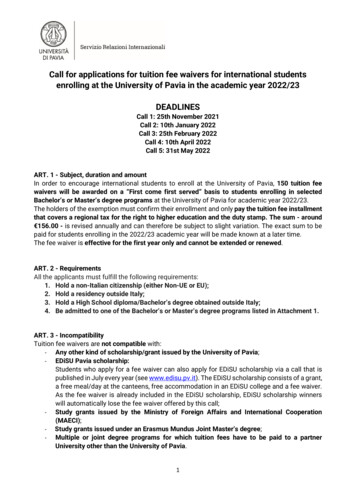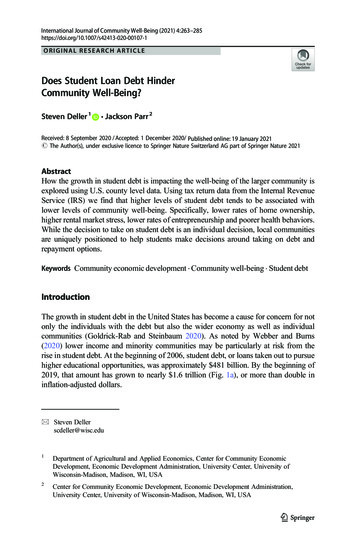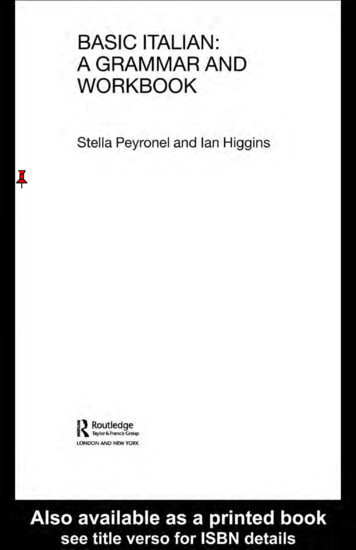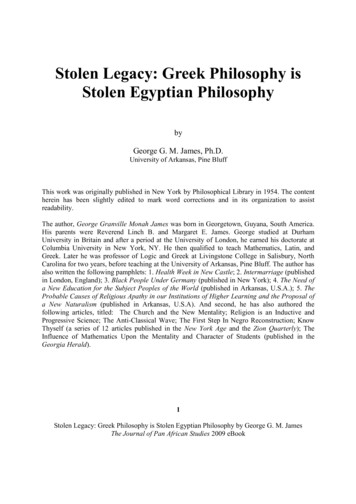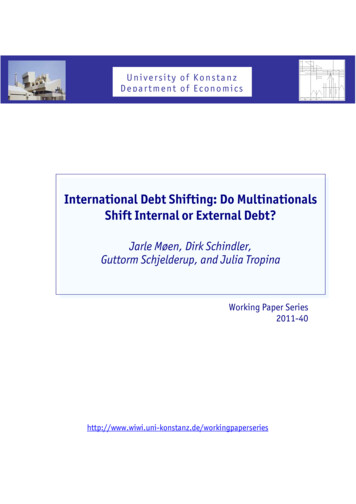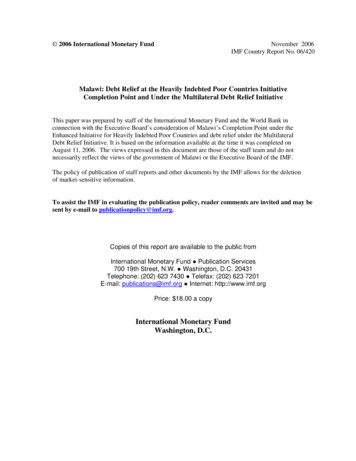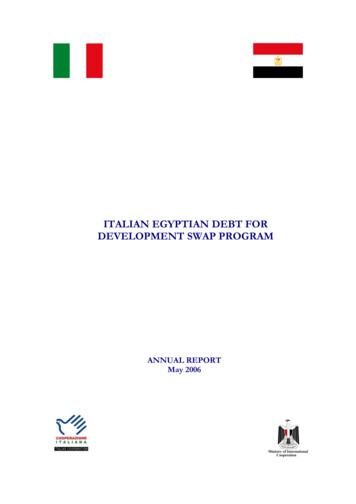
Transcription
ITALIAN EGYPTIAN DEBT FORDEVELOPMENT SWAP PROGRAMANNUAL REPORTMay 2006
Italian Egyptian Debt for Development Swap NODCCPWFPWNRDPWRRITSUNGO Association for the Advancement of EducationAgricultural Experimental StationNGO Association for the Development and Enhancement of WomenAgricultural Research CentreCentral Bank of EgyptCentral Labouratory for Environment Quality Monitoring - NWRCNGO Cooperazione per lo Sviluppo dei Paesi EmergentiCounterpart Fund of the Debt Swap programEgyptian Environmental Affairs AgencyGeneral Authority for Education BuildingNGO International Centre for Environment and DevelopmentItalian Egyptian Debt Swap ProgramInternational Fund for Agricultural DevelopmentExecutive Organization for Industrial and Mining Projects – MOFTIIntegrated Migration Information SystemManagement Committee of the Debt Swap programItalian Ministry of Foreign Affairs – General Directorate for CooperationMinistry of Agriculture and Land ReclamationMedio Credito Centrale ItalianoMinistry of Communication and Information TechnologyMinistry of Insurance and Social AffairsMinistry of Manpower and EmigrationMinistry of FinanceMinistry of Foreign Trade and IndustryMinistry of Health and PopulationMinistry of TourismNational Council for Childhood and MotherhoodNational Council for WomenNGO New Vision for DevelopmentNational Water Research Centre - Ministry of Water Resources and IrrigationProject Management UnitSupreme Council of AntiquitiesStrategic Research UnitUnited Nations Development ProgrammeUnited Nations Educational, Scientific and Cultural OrganizationUnited Nations Office for Drug Control and Crime PreventionWorld Food ProgrammeWest Nubariya Rural Development ProgrammeWater Resources Research InstituteTechnical Support Unit to the Debt Swap Management CommitteeIEDS Annual Report 20062
Italian Egyptian Debt for Development Swap ProgramTable of ContentsOrigins: the Debt Swap Agreement5The Counterpart Fund6Governing Bodies7Selection of Projects9Monitoring of the projects10Progress at May 200611Projects Data report1-West Noubaria Rural Development Project192-Poverty Alleviation Program213-Establishment of Data Base in Rural Areas with the Introduction of Family Health Approach234-Revitalization of Traditional Arts and Crafts and Environment in Old Cairo255-Sustainable Rural Development of Wadi El Rayan and Fayoum New Land Settlement266-Prevention and Control of the Risk of Chemical Poisoning and Unsafe Handling of Chemicals287-Marketing Link Programme: Linking Crafts Producers from Marginal Communities to National and International Markets308-Multi Faceted Women’s Development Project in Minya Governorate329-Completion of Pottery Village3410-Information and Communication Technologies to Foster Egypt’s Sustainable Human Development3511-Support to Local Agricultural Cooperatives Established in Newly Settled Areas in Upper Egypt3712-Protection of Working Children in Manshiet Nasser3913-School Feeding in Upper Egypt4114-Passive In-Stream Wetland Treatment of Drain Water4315-Environmental Impact Assessment of Drinking Water Using Hand-Pump Systems4416-Directory of Services for Persons with Special Needs in Greater Cairo Area4617-Female Genital Mutilation - Free Village Model4718-The National Project for Drug Abuse Demand Reduction among Youth4919-Schools Construction5120-Think Twice5321-Expansion of the Beheira School Health Programme5522-Egyptian-Italian Environmental Cooperation Programme – Phase II5723-National Biodiversity and Natural Heritage Inventory and Monitoring Systems5924-Evaluation, Development and Execution of some Flash Flood Protection Works at Wadi Watier – South Sinai6125-Water Resources Management for Agricultural Sustainable Development in the Southern Valley6226-Leprosy Elimination in Egypt6427-Participatory Slum Upgrading in El Hallouws and El Bahtini6528-Extension of the Medical Research Institute6729-Food for Work - Leprosary Village6830-Assessment of Water Users’ Associations in Egypt70IEDS Annual Report 20063
Italian Egyptian Debt for Development Swap Program31-A Strategic Long-Term Water-Based Food Security Model for Egypt7132-Integrating Community-Based Waste Management into International Contracting7233-HIV/AIDS Prevention and Control in Egypt7434-Brackish Water Desalination for Urbanization of Remote Arid Areas in Egypt7635-Support and Development Health Programmes for Working Children in 3 Governorates through Primary Health Care Level7736-Rural Development Communication Network (RADCON)7837-Traceability of Agro-Industrial Products for the European Market8038-Street Children Protection8239-Relocation and Development of Old Cairo Tanneries to Robaiki Area – First Phase8440-The Expansion of ADEW’s Program for the Empowerment of Female Heads of Houseold in Low-Income Communities8641-Northern Cairo Public Awareness Campaign for Environmental Development Project8842-Rehabilitation of Beheira Water Supply System9043-Professional Training for Restoration and Archaeology- Recovering of the Urban Area of the Yashbak Palace9244-Improving Living Conditions of Low Income Families in Three Districts of the Governorate of Sohag9345-Development of Women Entrepreneurship and Gender Equality Promotion9446-Improving Quality of Life for Children and Families in Old Cairo9647-Sustainable Development through Enhancement of NGOs Kindergarten Services9848-Improving Education Quality in Siwa10049-Creation of Sustainable Job Opportunities to Alleviate Poverty and Unemployment in Minya10250-Improving Living Conditions of Children with Special Needs in the Districts of Omranya and El Saff (Giza)10451-Infrastructural Support to External Employment Department of the Ministry of Manpower and Emigration10552-Dolphins Habitat Conservation and Sustainable Use10653-Pilot Project for Green Corridor108IEDS Annual Report 20064
Italian Egyptian Debt for Development Swap Program1 Origins: the Debt Swap Agreement“Debt Swap” is shorthand for a transaction in which a government or organization in a creditorcountry retires a fraction of a developing country’s external debt, in exchange for acommitment by the debtor government to invest local currency in designated programs. Inessence, the debt swap concept can also be viewed as a form of foreign assistance to a debtorcountry by its creditors, whether these creditors are commercial institutions or simply creditgranting governments.Italy and Egypt signed the “Debt-for-Development Swap” agreement in Rome on February 19,2001 with the aim of converting eligible Official Development Assistance (ODA) bilateral debtowed by the Arab Republic of Egypt to the Italian Republic into financial resources toimplement development projects in Egypt. The total amount of debt subject to swap operationsunder the Agreement is approximately 149 million for a period of five years (July 2001 – July2006).ITALIAN EGYPTIAN DEBT SWAP The Italian - Egyptian Debt Swap (IEDS) was established by a bilateralAgreement between Italy and Egypt, signed in Rome on February, 2001. The aim is to convert eligible Official Development Assistance (ODA) debtowed by Egypt to Italy into financial resources to implement developmentprojects in Egypt. The total amount of debt subject to swap operations under this Agreement isabout USD 149 millions for a period of 5 years: 9/7/01 – 8/7/06. Funds generated by the debt swap should finance development projects aimedmainly towards human development, poverty alleviation and environmentprotection.IEDS Annual Report 20065
Italian Egyptian Debt for Development Swap ProgramEgypt is one of a number of middle-income countries that have taken advantage of the ancial plan.IEDS Annual Report 20069
Italian Egyptian Debt for Development Swap Program5 Monitoring of the projectsFinancial and technical monitoring is very important for good management of the fund andthe sustainability of the projects. Every six months all projects are required to submit aprogress report to the MC. This specifies achievements, activities, results and expenditureaccording to the work plan targets. The progress report, which includes technical andfinancial data, is drafted according to a standard format.The TSU assist the Projects to draft the progress reports correctly, while at the same timeimproving the performance of the staff of the projects on technical and financialmanagement and thus adding to their skills base.MONITORING All projects are subject to close technical and financial monitoringduring their life cycle. Every six months each project has to present a technical and financialprogress report to the TSU. Field visits and regular meetings with projects staff are carried out bythe TSU.For financial monitoring the TSU has adopted the techniques of “Performance Budget”and “Activity Based Financial Planning” where expenditures are related to activitiesimplemented. Assisting the projects to adopt this vision required full involvement of theTSU in the area of capacity building, institutional empowerment and knowledge transfer toraise and upgrade the skills of the projects' staff. The philosophy behind this is not only tofacilitate the monitoring activities but also to express a strong commitment towardsimproving national institutions performance through capacity building. Within this widebroader vision the monitoring technique becomes part of the project learning processwhich eventually results in enhancing the project performance in management andreporting.When the necessary monitoring is done with an external auditor, this indicates the financialperformance of the implementer, and avoids any mismanagement of funds.IEDS Annual Report 200610
Italian Egyptian Debt for Development Swap ProgramCAPACITY BUILDINGThe monitoring activity of the TSU is extremely helpful in identifying thespecific needs of the different partners in relation to the management ofdevelopment projects. As a consequence, interventions for capacitybuilding are carried out by the TSU in order to improve projectsperformance, management and sustainability.Actions for capacity building are developed through: meetings with projects staff; themed workshops; guidelines and tools for project managementSYNERGIES AND LINKSIn order to strengthen projects IMPACT and SUSTAINABILITY, theTSU is deeply involved in promoting synergies and links among projects.This is achieved by facilitating meetings and specific activities involving: Projects funded by IEDS; Projects funded by the Italian Cooperation; Initiatives of international institutions and other donors.6 Progress at May 20066.1 Projects financedThe Italian Egyptian Debt Swap program finances 54 development projects, including pr.54concerning TSU running costs, with a total budget of EGP 835,284,174 as indicated in thefollowing list.IEDS Annual Report 200611
Italian Egyptian Debt for Development Swap PCAIRO YA GvMRICARITASNWRCNWRCICEDMOHPALEX UNIV.MOHPFAOMOFTITOFULTYMOFTIADEWNCCMBEHEIRA BU SALAMAMOFTIIDS - TSUMARLMISAMOHPUNESCOMALR / COSPEMOHPCOSPENCWMOTUNDPMALRNCCMMALR / WFPNWRC / CLEQMNWRC / CLEQMCARITAS / SETIUNDPNCCM / ARITASNWRCNWRCICEDMOHPALEX NDOIOMABU SALAMAACCIDS -TSUIEDS Annual Report 2006ProjectRural Development ProjectPoverty Alleviation & Employment gener.Family Health Rural Data BaseTraditional Arts and CraftsSustainable Rural DevelopmentRisk of chemical poisoningMarketing Link ProgramMulti-faceted Micro-credit for womenCompletion of Pottery villageICT for sustainable human developmentSupport to agricultural cooperativesProtection of working childrenSchool FeedingInstream wetland treatment of drain waterEnvironmental Impact for hand pumps waterDirectory for special needs servicesFGM Free Village mod.Campaign to reduce drug abuseSchools constructionThink Twice social campaigns for youthSchool Health programEnvironmental program phase 2Inventory of national bio-diversityFlash Floods Protection worksAgricultural Development in Southern ValleyLeprosy elimination programParticipatory Slum upgradingExtension of Medical Research InstituteFood for work - leprosarium villageAssessment of Water Users Associat.Water based Food securityCommunity Waste managementHIV/AIDS PreventionWater DesalinationImproving Health of working childrenRural Developm. Communication NetworkTraceability agro-indust. Prod. Europ.mark.Street Children protectionRelocation of Old Cairo TanneriesEmpowerment of Female heads householdEnvironmental Development AwarenessRehabilitation of water supply systemYashback Palace restoration trainingLiteracy and vocational training for childrenWomen entrepreneurshipImproving quality of life of children and famil.Enhancement of NGOs kindergartens serv.Improvement of EducationImprovement of job opportunitiesChildren with special needsSupport to External Employment DptProtecting Dolphin habitatGreen Corridor Pilot ProjectSupport to TSU running costs12LocationDuration yearsProjectBudget EGPWest NubariaAssyut, Qena, SohagBehera, KalubiaOld Cairo - El FustatWadi Rayan, FayoumMenia, Dakhalya, CaironationalMyniaOld Cairo - El FustatNationalUpper EgyptManshiet NasserFayoum, BeniSuef, MinyaGharbya, DakhalyaGharbya, KalyubyaGreater CairoUpper EgyptnationalMinya, Sharkia, SohagNationalNationalNationalNationalSouth nalNationalCairoNationalAlexandriaMenoufeia, Assiut, CairoNationalNationalCairoCairo, RobaikiCairo -Mansh NassserNorth CairoBeheiraCairoSohagGizaOld CairoNationalSiwaMinyaGizanationalMarsa AlamWest Nubarianational4,533y3m43y2m17 m3,52,54y8m333y3m3y2m3y2m22 m333,5333333,52,531 y 10 m314 m14 m32y9m32,5333332,53,522y3m321 y 11 0495.000TOT835.284.174
Italian Egyptian Debt for Development Swap Program6.2 Applicants and Implementing AgenciesThe share of the total budget among the projects according to type of applicant is thefollowing:EgyptianEgyptianNGOsNGOs17%17%Italian NGOsItalian %40%UN AgenciesUN Agencies2%2%MinistriesMinistries32%32%PROJECTS BY APPLICANTThe share of the total budget according to the type of implementing agency is thefollowing:EgyptianInstitutions28%Italian NGOs9%EgyptianNGOs19%UN Agencies21%Ministries23%PROJECTS BY IMPLEMENTING AGENCYThe difference between the two distributions is due to the fact that some projects approvedto Egyptian institutions or ministries are implemented with the support of UN agencies orNGOs.IEDS Annual Report 200613
Italian Egyptian Debt for Development Swap Program6.3 Geographic coverageThe projects financed cover almost the entire country: 22 projects are underway in theDelta, 22 in Greater Cairo and Giza, 2 in Sinai, 5 in Siwa, 15 in Fayoum, Minya and Sohag,13 in Qena and Aswan, 2 in the Red Sea area.Delta 22Greater Cairo and Giza 22Sinai 2Siwa 5Fayoum – Minya - Sohag 15Red Sea 2Qena- Aswan 13The total budget of the projects approved is shared among the main areas of the country asshown in the following chart.Upper Egypt16%Grater Cairo24%Sinai2%National21%Delta35%Fayoum2%IEDS Annual Report 200614
Italian Egyptian Debt for Development Swap Program6.4 Sectors of interventionsObviously there is going to be some overlap between the various areas of development andthe results of one project may be applicable in more than one sector. However, a simplisticbreak down of the total budget according to sector of intervention is shown in thefollowing chart. The large shares for the sectors of Rural development and ofMicroenterprises and SMEs are due to the relative weight of the two biggest projectsfinanced namely IDS/1 “West Nubaria Rural Development Project” and IDS/39“Relocation of Old Cairo Tanneries”.Ruraldevelopment24%Waterresources erprisesand SMEs26%6.5 Projects sizeThe share of the total amount of funds, EGP 835.284.174, among the projects according totheir budget size is the following: Micro projects (budget EGP 0-500.000): 5 projects with a total budget of EGP1,481,440, representing 0.18% of the funds. Small projects (EGP 500,001-2,000,000): 19 projects with a total budget of EGP32,619,086, representing 3.91% of the funds. Medium projects (EGP 2,000,001-20,000,000): 19 projects with a total budget ofEGP 161,606,426, representing 19.35% of the funds. Big projects (EGP 20,000,001-50,000,000): 8 projects with a total budget of EGP326,927,222, representing 39.14% of the funds. Mega projects (EGP over 50,000,000): 2 projects with a total budget of EGP312,650,000, representing 37.43% of the funds.IEDS Annual Report 200615
Italian Egyptian Debt for Development Swap ProgramTOTAL FUNDS BY PROJECTS SIZETOTAL FUNDS BY PROJECTS 00,000--Micro projectsMicro projects551,481,440Total Budget1,481,440Total BudgetSmall projectsSmall projects191932,619,08632,619,086Medium projects Big projectsMega ProjectsMedium projects Big projectsMega 61,606,426326,927,222312,650,0006.6 Financial figuresThe total amount credited by the Government of Egypt in the Counterpart Fund accounton 30/04/06 amounts to EGP 789,244,948 corresponding to the amount of US 143,750,811 which represents about 96 % of the total debt which should be convertedduring the five years period of conversion of the Agreement (July 2001 – July 2006)amounting to US 149,097,996.At 30/04/06 the total funds transferred from the CPF to the accounts of the projectsamount to EGP 543,211,205 representing about 68% of the amount credited until now tothe CPF by the Egyptian Government, leaving a balance of EGP 249,822,557.The total expenditures reported by the projects at 30/04/06 amount to EGP 378,928,083representing about the 70% of the related funds transferred to those projects.IEDS Annual Report 200616
Italian Egyptian Debt for Development Swap Total AmountTotal Amounttransferred to the transferred to theCPFProjects789,244,948Total Amountspent by theProjects543,211,205378,928,08368.83%69.76%As per April 2006 Total debt cancelled: USD 143,750,811 (96% of the total amount agreed) Total funds credited to the CPF: EGP 789,244,948. Total funds transferred from CPF to the projects: EGP 543,211,205 (68%of the amount credited). Total expenditures by projects: EGP 378,928,083IEDS Annual Report 200617
Italian Egyptian Debt for Development Swap Program7 Projects Data reportIEDS Annual Report 200618
Italian Egyptian Debt for Development Swap ProgramWEST NOUBARIA RURAL DEVELOPMENT PROJECTApplicant: Ministry of Agriculture and Land ReclamationImplementing Agency: Ministry of Agriculture and Land Reclamation(IDS – 01)Total Project Cost: LE 270,736,976IDS Share: LE 150,620,000Funds Transferred at May 2006: LE 102,549,857Other Contributions: LE 120,116,975Potatoes production in demo plotProject Duration: 4,5 yearsLocation: Noubaria (Gov. Alexandria,Beheira)Start Date: 16th September 2002Completion Date: 15th March 2007Veterinary servicesObjectiveThe project is jointly financed by the Italian Egyptian Debt Swap Programme, the InternationalFund for Agricultural Development (IFAD) and the Egyptian Government in an area of newlyreclaimed desert lands in West Noubaria (West Delta) covering about 56,000 feddans (23,520hectares). The area was recently settled by displaced farmers (67% of the population) andfamilies of recent graduates (33% of the population). The total number of beneficiaries of theproject is about 39,000 people living in 86 villages. The general objective of the project is toimprove quality of life of beneficiaries, enhancing the livelihood of the target population andincreasing sustainable economic activities.Expected ResultsThe project is structured around four main components. The main expected result of the first component, “Community Organization andDevelopment”, is the improvement of housing and general social services delivered to thepopulation of the project area. The second component “Technical Operations” expects to improve water management,agricultural and livestock production, through training and awareness. The third component is “Marketing Operations” and the expected result is theenhancement of the local marketing system through training, financial support and technicalassistance. The expected result of the fourth component, “Credit Facilitation and EnterpriseDevelopment”, is the availability of adequate financial resources and technical assistance tobeneficiaries wishing to establish new economic activities in t
IMIS Integrated Migration Information System M.C. Management Committee of the Debt Swap program MAE-DGCS Italian Ministry of Foreign Affairs - General Directorate for Cooperation MALR Ministry of Agriculture and Land Reclamation MCC Medio Credito Centrale Italiano MCIT Ministry of Communication and Information Technology


